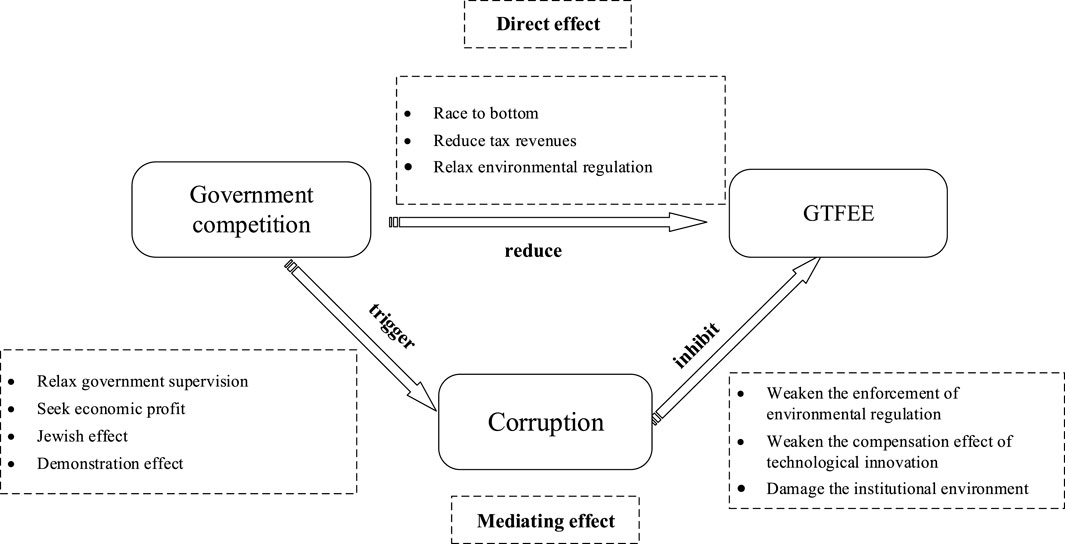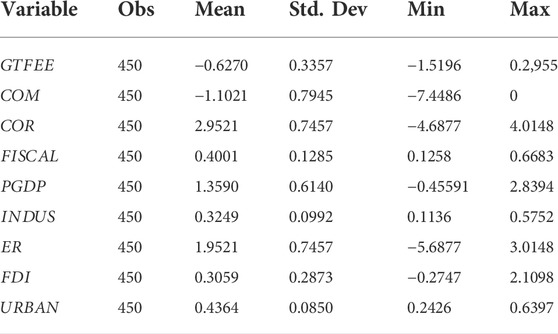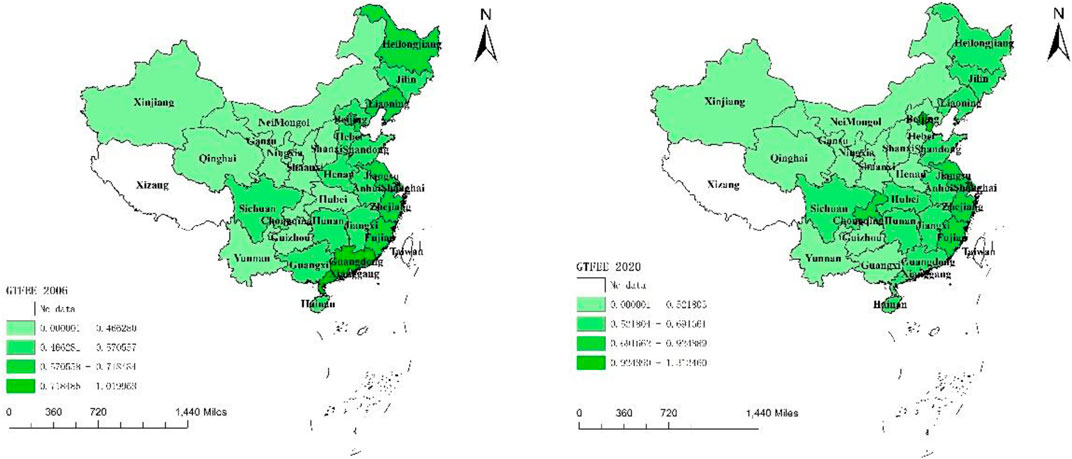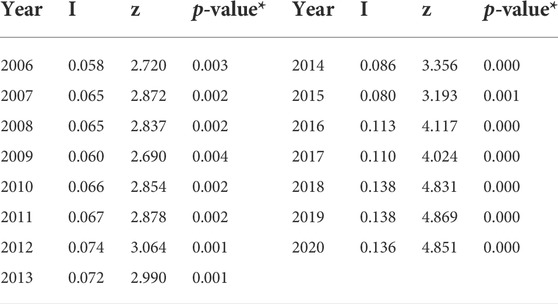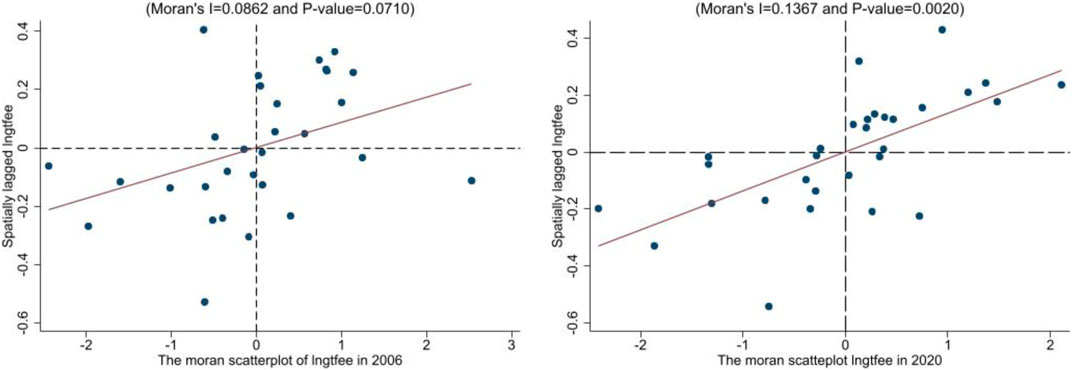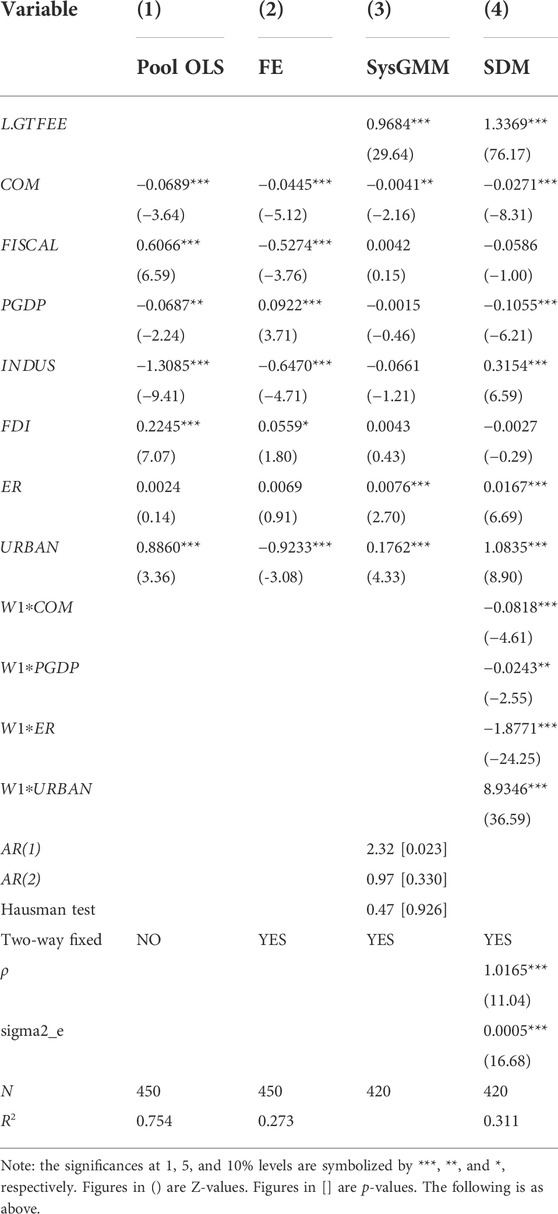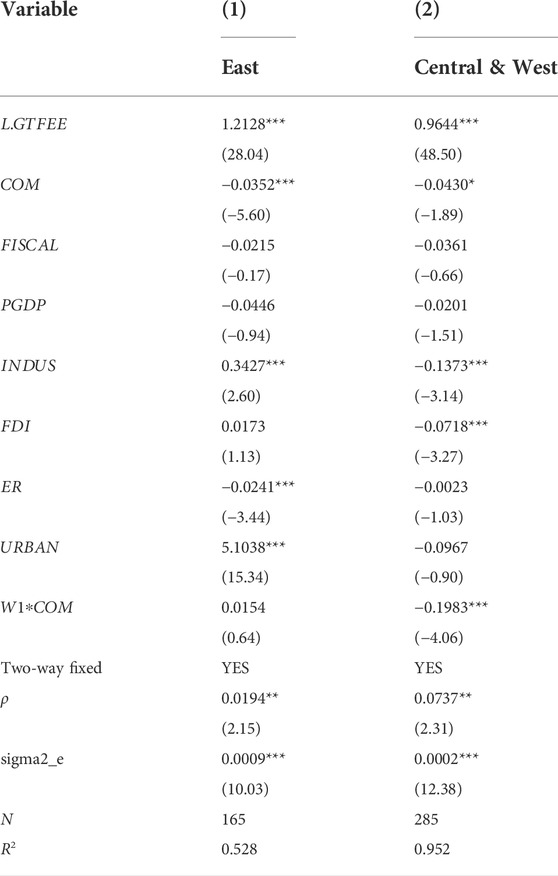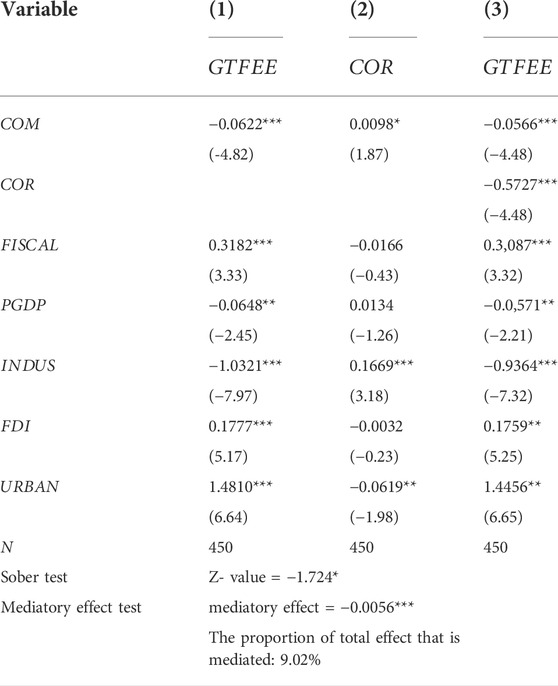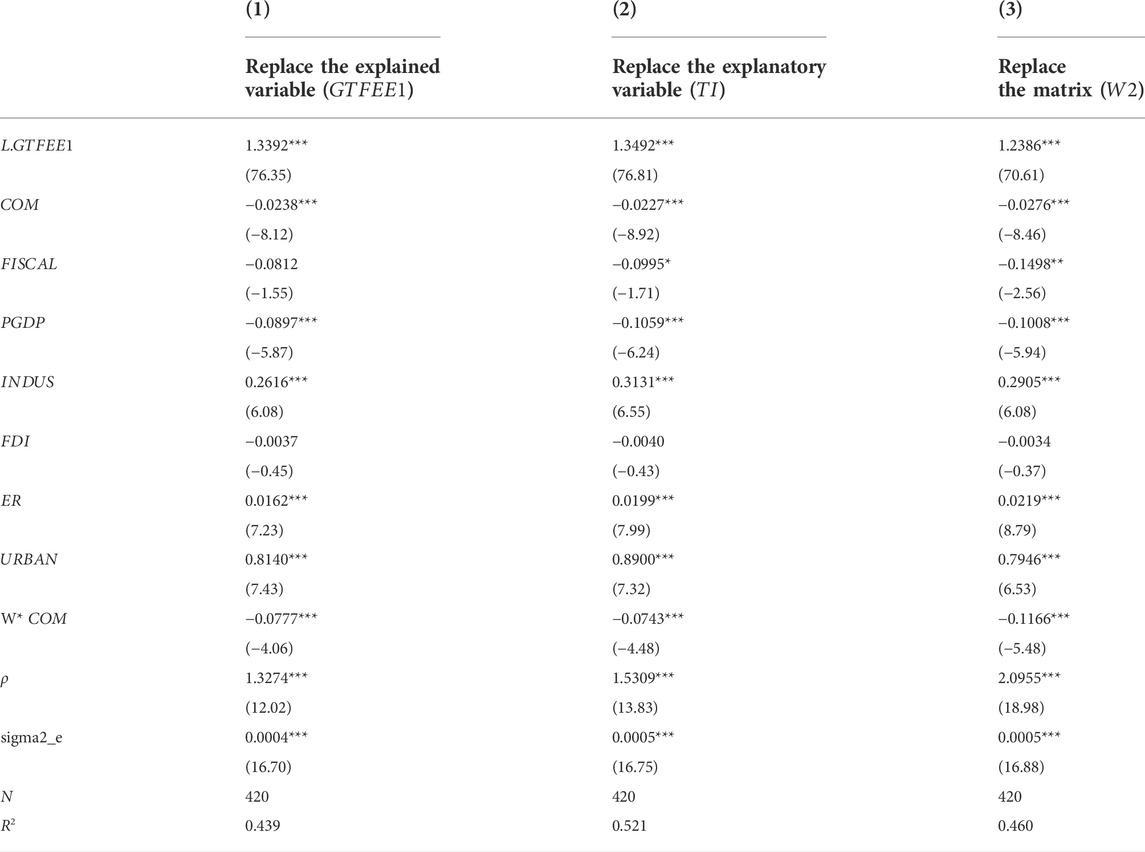- 1College of Economics and Management, Xinjiang University, Urumqi, China
- 2Institute of Higher Education, Chongqing Technology and Business University, Chongqing, China
- 3Xinjiang Institute of Technology, Aksu, China
- 4Researcher, Economic Research Institute, Development and Reform Commission of Xinjiang, Urumqi, China
- 5Center for Innovation Management Research of Xinjiang, Urumqi, China
- 6Shanghai Business School, Shanghai, China
Currently, global warming and resource and environmental constraints are becoming formidable. Improving green total factor energy efficiency (GTFEE) is an effective tactic to alleviate carbon emissions and resource scarcity, and also a practical demand for the sustainable and healthy development of China’s economy. This study applies the super efficiency SBM model to calculate GTFEE of China’s 30 provinces over the period from 2006 to 2020, and then the dynamic spatial Durbin model (SDM) is employed to investigate the impact of government competition on GTFEE. Furthermore, the influence path between government competition and GTFEE is identified by the intermediary effect model. The findings reveal that as a whole, local government competition has undermined GTFEE both in local and adjacent areas, but significant differences exist in different regions. After the robustness tests, the conclusions remain valid. The intermediary effect results show that government competition indirectly inhibits GTFEE by triggering corruption. Based on this, policymakers should establish an effective performance appraising for local governments to spark a cycle of virtuous competition and cooperation among regions. Meanwhile, the anti-corruption system should be improved so as to shape a favorable institutional atmosphere for the improvement of GTFEE, and ultimately promote the sustainable development of China’s economy.
1 Introduction
In recent decades, as a result of the drastic advancement of China’s urbanization and industrialization, the surge in energy consumption is awfully daunting (Hussain et al., 2020; Zhao et al., 2021). The report on China’s energy supply and demand reveals that 40% of the global energy consumption growth in 2020 is contributed by China. To make matters worse, China’s energy consumption demand has been skyrocketing as yet (Hao, et al., 2021; Zhao et al., 2022). Massive energy consumption is driving economic and social progress, but the ecosystem has been unavoidably thrown out of whack (Wang et al., 2020a). Severely ecological problems such as resource depletion, environmental pollution, and extreme weather are emerging one after another, which is heavily affecting the well-being and sustainable development of the Chinese nation. In the face of the current grim situation, the fifth Plenary Session of the 19th Central Committee of the Communist Party of China proposed the green development concept of “lucid waters and lush mountains are invaluable assets ", and the development goal of accelerating green and low-carbon transformation. In September 2020, Chinese President Xi Jinping claimed that China would adopt more effective to early achieve the goal of “carbon peak and carbon neutrality”. Under such goals and commitment, the contradiction between energy consumption and economic development becomes more prominent. Improving GTFEE becomes an imperative tactic to alleviate resource scarcity and carbon emissions so as to fuel economic green transformation and healthy development.
Government competition may substantially affect China’s economy and is regarded as a crucial impetus for its rapid rise and transformation. However, government competition may also trigger rent-seeking corruption in promoting economic development (Lee et al., 2020). Corruption, in turn, curbs economic development by hindering technological innovation (Wang and Wang, 2020) and distorting investment (Hao et al., 2020) and resource allocation (Wang S. et al., 2020). Meanwhile, corruption may aggravate environmental pollution by relaxing environmental regulations and frustrating the enthusiasm for energy innovation. Therefore, corruption has a grave impact on GTFEE. Pitifully, little concern is drawn to the research on the internal relationship between government competition, corruption and GTFEE.
Therefore, this study incorporates government competition, corruption, and GTFEE into a unified analysis framework, and explores the logical relationship between government competition, corruption, and GTFEE. This provides the theoretical basis and practical suggestions for optimizing economic structure, building a green ecological society, and coordinating economic and environmental development.
The remainder of the paper is developed as follows. Section 2 provides the literature review. Section 3 presents mechanism analysis and theoretical hypothesis. Section 4 demonstrates the research design. Section 5 provides the empirical analysis, while Section 6 gives the conclusions, policy implications, and further research directions.
2 Literature review
2.1 Government competition
Internationally, “local government competition” is also called “inter Jurisdictional Competition” (Brennan and Buchanan, 1980; Pan et al., 2017), “inter-regional competition” (Fawn, 2021), or “competitive government” (Breton, 1996; Zakari et al., 2022), and “competitive federalism” (Buchanan, 1995; Vanberg, 2016). The research on local government competition is thought to date back to Adam Smith, who pointed out in the wealth of nations that local governments compete essentially for capital. Tiebout (1956) put forward the famous theory of “voting with feet”1 in his article “A pure Theory on Local Expenditure”, which is called the Tiebout model. Breton (1989) completed the concept of “local government competition”. He stressed that “governments are naturally competitive and will compete with each other for the distributions of the resources and controlling rights, along with public goods and services ". Afterward, foreign scholars conducted in-depth research on local government competition, and the theme extended to a variety of competitions among local governments such as capital tax competition (Eichner and Pethig, 2019; Tamai and Myles, 2022), scale competition (Handley and Mathew, 2020), infrastructure competition (Asturias et al., 2019; Álvarez-SanJaime et al., 2021), financial competition (Grout, 2021), and regulatory competition (Gersbach et al., 2020; Haselmann and Tröger, 2021).
The theoretical analysis of the impact of local government competition on GTFEE consists of the following aspects: 1) the behaviors between local governments are strategic interaction, and there is a “spillover effect”, which is representatively manifested in three ways: competing to reduce tax rate (Eichner and Pethig, 2019), to increase financial expenditure (Xie et al., 2021), and to reduce the level of environmental regulation (Woods, 2006); 2) The purpose of local government’s strategic interaction behavior is to obtain the entry of liquidity factors such as capital and labor force (Hong et al., 2020); 3) Under the unified jurisdiction, the motivation of local government strategic interaction is also “yardstick competition" (Shen and Zhou, 2020). Different from the spillover effect and the mechanism of obtaining liquid resources, “yardstick competition” focuses on using the “relative performance” to settle information asymmetry in the principal-agent framework (Căpraru, et al., 2022).
2.2 Energy efficiency
With the increasingly tight resource constraints, the research on energy efficiency has attracted much attention from scholars. The research mainly focuses on energy efficiency calculation and its influencing factors.
The measurement of energy efficiency mainly includes two methods: single factor energy efficiency (SFEE) and total factor energy efficiency (TFEE). The former is measured by the proportion of economic output to energy input or the ratio of energy input to economic output. Compared with SFEE, TFEE means energy efficiency, which can better reflect the relationship between energy and economy, and has been popularized in the academic circle (Arabi et al., 2014; Zhao et al., 2014; Zhang et al., 2020).
Improving energy efficiency is so imperative for the sustainable development of China’s economy that a large number of scholars have carried out abundant studies on its influencing factors. Most of them maintain that industrial structure, technological progress, ownership reform, and R&D expenditure are dominant contributing factors to energy efficiency (Li and Lin, 2018; Xiong et al., 2019; Wang et al., 2020b; Zhao and Lin, 2020; Zhang and Fu, 2022). Hu & Wang (2006) initially proposed a basic framework to calculate TFEE. Some scholars refer to this framework to calculate TFEE and studied its influencing factors, finding that per energy price, energy consumption structure, capita income, and energy policy would also exert an obvious impact on it (Gamtessa and Olani, 2018; Bertoldi and Mosconi, 2020; Gillingham et al., 2020; Zakari et al., 2022). However, TFEE index of Li et al. (2022) solely includes the desirable output. Wang et al. (2022) ever argued that the pollution emissions from energy consumption must be considered in the calculation of energy efficiency, which is also a social cost and can negate the positive effect of desirable output. Because of this, some scholars began to take consider undesirable output into account in measuring energy efficiency (Hao et al., 2020; Wu et al., 2020a; Wu et al., 2020b).
2.3 Government competition and energy efficiency
Most studies have focused on the impact of industrial structure upgrading (Xiong et al., 2019), technological progress (Saygin et al., 2011; Lee et al., 2022), environmental regulation (Hao et al., 2022), and marketization (Zhao and Hu, 2020) on energy efficiency. However, few studies explore the correlation between local government competition and energy efficiency. For example, the competition in energy tax may have different effects on energy efficiency.
Aguiar and Bils (2015) argue that local governments can promote local economic growth by attracting foreign resource inflows through institutional innovation and tax incentives. However, under resource constraints, in order to prevent the outflow of resources, local governments will adopt local protectionism, which will increase regional transaction costs, thus reducing energy efficiency and hindering regional economic growth (Wang et al., 2022).
Although there is more and more research literature on government competition, corruption and GTFEE, there still exist deficiencies in this field. Firstly, few studies explored how government competition and corruption affect GTFEE. Secondly, the research on government competition and GTFEE needs to be further explored, and the internal mechanism deserves to be further clarified. In addition, government competition, corruption, and GTFEE are spatially dependent, but existing studies ignore the spatial correlation. Accordingly, the possible contributions are the following: 1) The study includes government competition, corruption, and GTFEE into a unified framework to investigate how government competition and corruption impact GTFEE and the transmission mechanism. 2) The dynamic SDM is constructed for econometric analysis, which effectively reflects the spatial correlation of the variables. 3) From the perspective of corruption, the study expands the previous relevant studies on influencing factors of GTFEE and further improves the influence mechanism of government competition and GTFEE.
3 Mechanism analysis
3.1 Impact of government competition on green total factor energy efficiency
Breton once defined “local government competition” more precisely, which means the behavior of local governments to attract funding, labor force, and mobile factors employing taxation, education, medical treatment, social security, environmental policies, and other means to upgrade the advantage in competition (Hao et al., 2022). The factors in the market abide by the law of “voting with their feet” in pursuing profits. Therefore, economic competition is essentially a behavior of local governments to compete for factors by their preferential terms, aiming to achieve economic targets or maintain regional superiorities.
How economic competition affects energy efficiency may depend on what factors local governments need to drive economic development. Economic competition provokes a “race to the bottom” in energy and ecological efficiency. Wu and Lin (2021) and Zakari et al. (2022) deem that local governments may take the strategy of reducing tax revenues or relaxing environmental regulations or both the aforementioned in order to win a competitive edge and increase the tax base. Local government tax competition aggravates environmental pollution. On the one hand, a low tax rate is detrimental to making up for the negative externalities of environmental pollution; On the other hand, it impels local governments to loosen environmental regulations such as lowering environmental entry barriers (Khan S. U. et al., 2021; Khan S. A. R. et al., 2021). Such a “race to the bottom " forces local governments to spend less time and financial resources on energy savings, environmental governance, and social welfare improvement, causing the deterioration of regional development quality, the aggravation of pollution, and the decline of energy and ecological efficiency.
Wang and Wang (2020) utilized the provincial data to study how fiscal decentralization and government competition affect environmental governance, finding that government competition significantly amplifies the negative effect of fiscal decentralization on environmental governance, so it is responsible for insufficient investment in environmental control. Under the fiscal decentralization system, local governments are enormously enthusiastic about the economic competition by attracting investment to raise their financial and material strength. However, in order to attract more regional investment, the local governments tend to introduce many high-energy-consumption and pollution-intensive enterprises due to the limited local resource endowment and input factors, which is bound to increase the ecological pressure and the loss of social welfare, further decreasing regional energy ecological efficiency.
Under the “Chinese style decentralization”, local governments carry out fierce competition due to the financial and political incentives from the central government, including tax competition, expenditure competition, and regulation competition (Lin and Xu, 2019). At the same time, deluded by private interests from enterprises, local governments collude with enterprises, so corruption is triggered, which further stimulates the strategic interaction and incomplete implementation of environmental regulation. What’s more, as the demander of environmental public goods, the public has the right and obligation to supervise the central government and enterprises (Hao et al., 2022). Therefore, the public’s demand for environmental protection will be a constraint factor for the interaction and incomplete implementation of environmental regulation, driving local governments to strengthen environmental pollution control and supervision (Wu et al., 2020).
Accordingly, Hypothesis 1 is assumed: local government competition hinders the improvement of GTFEE.
3.2 Impact of government competition on corruption
Government competition is apt to trigger corruption (Bliss, and Tella, 1997; Wu et al., 2022). Under the lure of economic gains, local governments will constantly expand their staff to attract investment and scramble for policies and resources from the central or superior departments. The staff increase will lead to difficulties in government supervision. In addition, it will reduce the income of local government officials, which will force them to seek more profitable activities. All of these increase corruption. Secondly, local government competition will promote privatization and marketization, which will make local officials much more concerned with the power of money and weaken the restraint power of traditional morality. Thirdly, under the dual constraints of carbon constraint performance and GDP performance, when local governments meet the assessment requirements of their superiors, they cannot respond to the needs of the market (Lee and Liu, 2022). In fact, to complete the task of attracting investment, some local governments will reduce land prices or taxes, and use local fiscal revenue to “support” or attract enterprises. In order to obtain this priority access, enterprises will use various improper means to lure local governments, which leads local officials to touch corruption. Last but not the least, the political environment is a key factor in whether local government competition will induce corruption. (Ryvkin and Serra, 2020; Ren et al., 2022). By and large, the looser the political environment, the weaker the anti-corruption ability, and more corruption will occur. Therefore, due to the differences in the political environment of various regions, local government competition may have different effects on corruption.
To this end, Hypothesis 2 is proposed: local government competition may induce local corruption, but the effect may be different in different regions.
3.3 Mediating effect of corruption
Corruption plays a key role when government competition affects GTFEE. Under fiscal decentralization, local governments have a large number of fiscal revenue and expenditure rights. With the discretion of a large number of local affairs, local governments have huge economic and administrative resources, which makes local government officials face many temptations. Some bureaucrats or interest groups get more convenience and political patronage for themselves by tempting local government officials to make use of their huge economic and administrative resources. Moreover, due to the local governments’ strong position in China’s social structure, their economic and administrative power is less supervised and balanced, leading to corruption such as power and money trading. More and more studies show that corruption exerts a great negative impact on the ecological environment. Corruption affects environmental sustainability and aggravates environmental pollution by relaxing environmental regulations (Leitão, 2010; Yu, 2019; Liu and Dong, 2021). For example, the impact of the “shadow economy” on pollution depends on corruption in the public sector (Sohail et al., 2021). Corruption will inhibit GTFEE. Due to government corruption, enterprises gain profits by continuously using outdated technologies, and thus their enthusiasm for the development and utilization of new energy fails to be mobilized. In the context of increasingly tight environmental resource constraints, local government competition exacerbates environmental pollution by triggering corruption and the role of government corruption is more prominent. Generally, the dual incentives of local government economic catch-up and official promotion strengthen the policy preference oriented by growth and promotion, which may lead to environmental corruption, namely, the economic growth mode at the cost of environmental pollution, and GTFEE is reduced in this manner.
Hence, Hypothesis 3 is put forward: Corruption acts as a bridge in the impact of government competition on GTFEE.
Figure 1 is presented to clarify the mechanism of how government competition affects GTFEE through corruption.
4 Research design
4.1 Spatial weight matrix
According to Tobler’s First Law of Geography, all things are related, but nearby things are more related than distant things (Tobler, 1970), so it is necessary to set up a spatial weight matrix to represent the spatial correlation and dependence between spatial units. It is very important to choose an appropriate spatial weight matrix to explore the impact of government competition on green total factor productivity. However, in the existing literature on influencing factors of GTFEE, the spatial correlation of influencing factors of energy efficiency is insufficient. Existing research mainly used 0–1 adjacency matrix (Cheng et al., 2020; Wu et al., 2020b; Zhang et al., 2022) or geographic distance matrix (Wu et al., 2020a; Wang et al., 2022; Wang et al., 2022c) to reflect the spatial correlation. These studies only consider the geographical factors but ignoring the influence of economic factors. In fact, due to convenient transportation, the farther the distance between cities, the weaker the correlation degree may be, but they can still have economic exchanges with each other. Therefore, it is inappropriate to simply adopt 0–1 adjacency matrix or geographic distance matrix. In addition, the premise of this kind of matrix is that the mutual influence is equal, which is not consistent with the economic fact. Compared with the existing literature, we construct the nested matrix of economic geography (
Where
In addition, we construct the inverse distance space weight matrix (
Where,
4.2 Empirical model setting
The theory of spatial econometrics suggests that almost all spatial data have the characteristics of spatial dependence or spatial autocorrelation (Anselin, L., 2013), which has been confirmed in the research of Hao and Wu (2020).
Anselin (2013) further pointed out that the spatial econometric model mainly involves three models: spatial Lag model (SLM), spatial Error model (SEM), and spatial Durbin model (SDM). SDM takes the spatial autocorrelation of variables into account and can test the spillover effect of variables. Therefore, this paper constructs the dynamic SDM to fully investigate how government competition and corruption affect GTFEE, as shown in formula Eq. 1:
In formula Eq. 1,
Based on the research of Baron and Kenny (1986), this paper further constructs mediating effect model to judge the potential impact of local government competition on GTFEE. To alleviate the endogeneity, this paper utilizes the system generalized moment estimation (SYS-GMM) for regression.
Where,
4.3 Variables and data
4.3.1 Explanatory variable
Green total factor energy efficiency (
In calculating GTFEE, input variables, intentional output, and unintended output variables are included. Among them, the input variables are capital input, labor input, and energy input. Capital input (k) is calculated by the perpetual inventory method (Shan, 2008) which calculates the total fixed-asset investment and fixed asset price index of provinces. The formula is as follows
In formula Eq. 7,
Assuming that each DMU has
Many scholars have found that when the efficiency of DMU is 1, the optimal efficiency DMU becomes meaningless to compare horizontally. In order to overcome the disadvantage, Tone (2004) came up with a super-efficiency SBM of undesirable output. Use
Finally, an improved SBM undesirable model is established, as shown in Eq. 11:
4.3.2 Explanatory variable
Local government competition (
Where
4.3.3 Mediating variable
The above theoretical analysis suggests that local government competition may affect GTFEE by triggering correction. This paper takes corruption (
4.3.4 Control variables
To control other factors that may affect GTFEE, industrial structure (
4.4 Data description
This paper samples China’s 30 provinces from 2006 to 2020, excluding Hong Kong, Macao, Taiwan, and Tibet due to the data missing. The interpolation method is employed to supplement the missing data. The relevant data except for GTFEE are from China’s statistical yearbook of all kinds and China’s statistical database. The descriptive statistical results of relevant variables are shown in Table 1.
5 Empirical analysis
5.1 Analysis of spatial correlation
This paper uses arcgis10.6 to draw a quadrant map of GTFEE to intuitively reflect the regional differences and dynamic changes of GTFEE in China. On account of confined space, the distribution maps of GTFEE in 2006 and 2020 are presented in Figure 2. It can be seen that economically developed regions such as Beijing, and Tianjin are dominant in the dark green regions with the highest GTFEE. Additionally, the dark green areas increased from 2006 to 2020, implying that China’s GTFEE is being gradually improved. The reason is that the governments have changed the promotion and incentive objectives, taking the intensive use of resources and the restriction of pollutant emission as binding indicators, which has strengthened the environmental governance of local governments. In this manner, energy efficiency has been greatly improved.
Table 2 shows the Moran’s I index of China’s GTFEE from 2006 to 2020. It can be found that Moran’s I index of GTFEE is positive at the significance level of 1% from 2006 to 2020, suggesting that in the whole region, China’s GTFEE has obvious spatial positive correlation and spatial agglomeration.
The local Moran scatter diagram (Figure 3) is used to vividly demonstrate the spatial agglomeration of GTFEE. We can see that the scatter points are mainly located in the first quadrant (high-low agglomeration), the third quadrant (low-low agglomeration), and the fourth quadrant (low-high agglomeration), and as time goes on, the agglomeration trend of environmental pollution moves to the first quadrant (high-high agglomeration).
5.2 Spatial econometric model selection test
Considering the spatial correlation, this paper preliminarily sets SDM and then conducts the model applicability test. The test results in Table 3 show that all tests pass the significance test, indicating the dynamic SDM with spatiotemporal double fixed effect is appropriate for the empirical test.
5.3 Analysis of estimation results of spatial durbin model
5.3.1 National sample analysis
This paper mainly uses the dynamic SDM model for parameter estimation. For better comparative study, the estimations of the non-spatial panel OLS model 1), panel fixed effect model 2), system Gaussian Mixed Model 3), and dynamic Spatial Dubin Model (SDM) 4) are also listed in Table 4.
It can be seen from Table 4 that the lag term of GTFEE is significant at the level of 1%, indicating that there is an obvious “time inertia" (Yang C. et al., 2021; Yan et al., 2022). If the GTFEE is at a high level at this moment, it may continuously be rising in the following days, thus showing the “snowball effect”.
Additionally, both in the non-spatial panel model and spatial panel model, the estimation coefficients of government competition on GTFEE are negative, indicating that as a whole, government competition hinders the improvement of GTFEE. The possible reason is that local governments intend to adopt the competitive strategy of the low tax burden or relax environmental regulations or both to gain an economic competitive edge (Liu and Dong, 2021; Ren et al., 2021). This distorted behavior will cause the “contagion” effect among regions, resulting in the same direction chain change of regional environmental supervision behavior (Hao et al., 2022). The “race to the bottom” of government competition and the “adverse selection” of the market have caused the withdrawal of enterprises with high environmental standards and high production efficiency from the market. Under the factor curse trap and the “pollution paradise” effect, the path dependence of the regional economy on the extensive development model has become stronger and stronger (Candau and Dienesch, 2017; Yang X. et al., 2021), thus hindering the improvement of GTFEE. Hypothesis 1 was tested.
The estimation coefficient
5.3.2 Regional heterogeneity analysis
To further explore the regional differential impact of government competition on GTFEE, the samples are divided into Eastern, and Central & Western regions, and the dynamic SDM is used to estimate the regional differential impact. The estimations are presented in Table 5.
Table 5 shows that the impact of local government competition on GTFEE has not only characteristics in common but also regional differences. In terms of the main effect, for all regions, the coefficients
5.3.3 Mechanism test
Generally, the local government competition can reduce GTFEE. In the following, the mechanism will be further analyzed. In this paper, a step-by-step test (Baron and Kenny, 1986) is applied to verify whether the intermediary effect exists. Equations 2–4 are the intermediary effect test models. What’s more, the bootstrap method has a high statistical effect and is recognized as a method that can replace the Sobel method and directly test the coefficient product (Yan et al., 2021).
Table 6 shows that
5.3.4 Robustness test
To further verify the reliability of the estimations, the following tests are carried out by using SDM, and the results are shown in Table 7.
1) Recalculate the explained variable. Non-radial distance function (NDDF)is employed to remeasure GTFEE by taking capital, labor, and energy as input factors, GDP as desirable output, and pollution emission as undesirable output (Lin and Xu, 2019). 2) Recalculate the explanatory variable. Tax intensity (
6 Conclusion and policy implication
Based on the data of 30 provinces in China excluding Hong Kong, Macao, Taiwan, and Tibet from 2006 to 2020, this study empirically tests the relationship and internal mechanism between government competition, corruption, and GTFEE by using SDM and intermediary effect model. The findings show that: 1) In general, local government competition considerably reduces the regional GTFEE. After the robustness test, the conclusion is still valid. 2) Regional heterogeneity shows that local government competition in the western region has a greater inhibitory effect on GTFEE than that in the eastern region. As for the spatial spillover effect, the local government competition in the eastern region promotes GTFEE, whereas hinders GTFEE in the central and western regions. 3) Government competition indirectly inhibits the improvement of regional GTFEE by triggering corruption and the mediating effect accounts for 9.02%.
Accordingly, in order to achieve sustainable and healthy development of China’s economy, policymakers should take government competition as the starting point to improve regional GTFEE. Firstly, scientifically guide and regular the horizontal competition among local governments. When local economic development is backward and the government’s financial resources are insufficient, local government competition fails to play its positive role. Therefore, tax competition has necessarily become the main means of horizontal competition among regions. However, as China’s economic development enters the middle stage of industrialization and the new era of people’s livelihood, it is urgent to guide local governments to carry out the benign and orderly competition by reforming the performance evaluation system of local government officials, to reduce local governments’ excessive dependence on tax competition, and realize the transformation from tax competition to expenditure competition Meanwhile, make full use of the positive effects of expenditure competition on resource allocation to alleviate the negative effects of tax competition and promote high-quality economic development.
Secondly, adopt differentiated local competition strategies. According to local conditions, the primary and secondary competitive motives should be distinguished in line with the actual needs of local governments. The local government should choose the different game objects and strategies according to competitive motivation. When adopting the strategy of “Race to the bottom” to attract economic interests, it is necessary to avoid the occurrence of collective irrational vicious competition caused by individual rationality. For most local governments, they should carry out benign competition (such as moderate race-to-top competition) and cooperation to deal with the contradiction of environmental regulation among local governments, getting out of the dilemma of short-term interests and long-term returns, and gradually improving GTFEE.
Thirdly, the local government should improve the anti-corruption system to curb corruption among local officials so as to reduce the negative effect of corruption on GTFEE (Hao et al., 2020). Specifically, they should carry out warning education to build a strong defense line against corruption ideologically. In this manner, corruption is nipped in the bud. On the other hand, they should strengthen supervision over rights, improve the supervision system of law, democracy, public opinion, and the masses, exposing the behavior of local government officials to the public so as to provide a good institutional environment for the improvement of green energy efficiency.
Although this study has conducted an in-depth discussion on the relationship between government competition, corruption, and GTFEE, the exploration is insufficient. Firstly, this study is made by using provincial data due to data availability, and prefecture-level city data should be used for further research, which can reduce the errors caused by large spatial scale and internal differences. Secondly, this study has verified that corruption is a partial intermediary variable of government competition affecting GTFEE, indicating that there are other transmission paths, which deserve to be further explored in future research.
Data availability statement
The raw data supporting the conclusions of this article will be made available by the authors, without undue reservation.
Author contributions
JZ: Conceptualization, Project administration, Writing - review and editing, Writing original draft, Funding acquisition. JY: Writing - review and editing, Software, Visualization, Formal analysis. XY: Writing - review and editing, Validation, Formal analysis. CN: Methodology, Formal analysis, Funding acquisition, Supervision. QR: Writing - review and editing, Validation, Funding acquisition, Supervision. HS: Writing - review and editing, Formal analysis, Funding acquisition.
Funding
The authors acknowledge financial support from the National Natural Science Foundation of China (71963030), the National Natural Science Foundation of China (41661112), the National Natural Science Foundation of China (71463057), the National Social Science Foundation of China (20XJL012), National Science and Technology Major Project of the Ministry of Science and Technology of China (SQ2021xjkk01800), Xinjiang Social Science Foundation of China (21BJY050), and the Humanities and Social Sciences Program Chongqing Municipal Education Commission (18SKSJ034).
Conflict of interest
The authors declare that they have no known competing financial interests or personal relationships that could have appeared to influence the work reported in this paper.
Publisher’s note
All claims expressed in this article are solely those of the authors and do not necessarily represent those of their affiliated organizations, or those of the publisher, the editors and the reviewers. Any product that may be evaluated in this article, or claim that may be made by its manufacturer, is not guaranteed or endorsed by the publisher.
Footnotes
1Voting with your feet refers to the flow of capital, talent and technology to areas that can provide better public services after barriers are removed.
References
Aguiar, M., and Bils, M. (2015). Has consumption inequality mirrored income inequality? Am. Econ. Rev. 105 (9), 2725–2756. doi:10.1257/aer.20120599
Álvarez-SanJaime, Ó., Cantos-Sanchez, P., Moner-Colonques, R., and Sempere-Monerris, J. J. (2021). The effect of cooperative infrastructure fees on high-speed rail and airline competition. Transp. Policy 112, 125–141. doi:10.1016/j.tranpol.2021.08.010
Anselin, L. (2013). Spatial econometrics: methods and models, 4. Dordrecht: Springer Science & Business Media.
Arabi, B., Munisamy, S., Emrouznejad, A., and Shadman, F. (2014). Power industry restructuring and eco-efficiency changes: A new slacks-based model in malmquist–luenberger index measurement. Energy Policy 68, 132–145. doi:10.1016/j.enpol.2014.01.016
Asturias, J., García-Santana, M., and Ramos, R. (2019). Competition and the welfare gains from transportation infrastructure: Evidence from the Golden Quadrilateral of India. J. Eur. Econ. Assoc. 17 (6), 1881–1940. doi:10.1093/jeea/jvy039
Baron, R. M., and Kenny, D. A. (1986). The moderator–mediator variable distinction in social psychological research: Conceptual, strategic, and statistical considerations.. J Pers Soc Psychol. 51 (6), 1173.
Bertoldi, P., and Mosconi, R. (2020). Do energy efficiency policies save energy? A new approach based on energy policy indicators (in the EU member states). Energy Policy 139, 111320. doi:10.1016/j.enpol.2020.111320
Bliss, C., and Tella, R. D. (1997). Does competition kill corruption? J. political Econ. 105 (5), 1001–1023. doi:10.1086/262102
Brennan, G., and Buchanan, J. M. (1980). The power to tax: Analytic foundations of a fiscal constitution. New York, NY: Cambridge University Press.
Breton, A. (1989). The growth of competitive governments. Can. J. Econ. 22, 717–750. doi:10.2307/135496
Candau, F., and Dienesch, E. (2017). Pollution haven and corruption paradise. J. Environ. Econ. Manag. 85, 171–192. doi:10.1016/j.jeem.2017.05.005
Căpraru, B., Georgescu, G., and Sprincean, N. (2022). Do independent fiscal institutions cause better fiscal outcomes in the European Union? Econ. Syst. 46, 100973. doi:10.1016/j.ecosys.2022.100973
Cheng, Z., Liu, J., Li, L., and Gu, X. (2020). Research on meta-frontier total-factor energy efficiency and its spatial convergence in Chinese provinces. Energy Econ. 86, 104702. doi:10.1016/j.eneco.2020.104702
Eichner, T., and Pethig, R. (2019). Strategic pollution control and capital tax competition. J. Environ. Econ. Manag. 94, 27–53. doi:10.1016/j.jeem.2019.01.002
Fawn, R. (2021). ‘Not here for geopolitical interests or games’: the EU’s 2019 strategy and the regional and inter-regional competition for central asia. Cent. Asian Surv., 1–24. doi:10.1080/02634937.2021.1951662
Gamtessa, S., and Olani, A. B. (2018). Energy price, energy efficiency, and capital productivity: Empirical investigations and policy implications. Energy Econ. 72, 650–666. doi:10.1016/j.eneco.2018.04.020
Gersbach, H., Haller, H., and Papageorgiou, S. (2020). Regulatory competition in banking: Curse or blessing? J. Bank. Finance 121, 105954. doi:10.1016/j.jbankfin.2020.105954
Gillingham, K., Rapson, D., and Wagner, G. (2020). The rebound effect and energy efficiency policy. Rev. Environ. Econ. Policy.
Grout, P. A. (2021). AI, ML, and competition dynamics in financial markets. Oxf. Rev. Econ. Policy 37 (3), 618–635. doi:10.1093/oxrep/grab014
Handley, C., and Mathew, S. (2020). Human large-scale cooperation as a product of competition between cultural groups. Nat. Commun. 11 (1), 702–709. doi:10.1038/s41467-020-14416-8
Hao, Y., Gai, Z., and Wu, H. (2020). How do resource misallocation and government corruption affect green total factor energy efficiency? Evidence from China. Energy Policy 143, 111562. doi:10.1016/j.enpol.2020.111562
Hao, Y., Guo, Y., and Wu, H. (2022). The role of information and communication technology on green total factor energy efficiency: Does environmental regulation work? Bus. Strategy Environ. 31 (1), 403–424. doi:10.1002/bse.2901
Hao, Y., Kang, Y., Li, Y., Wu, H., and Song, J. (2022). How does environmental regulation affect economic growth? Evidence from beijing-tianjin-hebei urban agglomeration in China. J. Environ. Plan. Manag., 1–28. doi:10.1080/09640568.2022.2042795
Hao, Y., Song, J., and Shen, Z. (2021). Does industrial agglomeration affect the regional environment? Evidence from Chinese cities. Environ. Sci. Pollut. Res. 29, 7811–7826. doi:10.1007/s11356-021-16023-6
Haselmann, R., and Tröger, T. (2021). What are the main differences between the practice of supervising large banks in the UK and the euro area, and what are the main risks of regulatory divergence? SAFE White Paper. (No. 86).
Hong, Y., Lyu, X., Chen, Y., and Li, W. (2020). Industrial agglomeration externalities, local governments’ competition and environmental pollution: Evidence from Chinese prefecture-level cities. J. Clean. Prod. 277, 123455. doi:10.1016/j.jclepro.2020.123455
Hu, J. L., and Wang, S. C. (2006). Total-factor energy efficiency of regions in China. Energy policy 34 (17), 3206–3217. doi:10.1016/j.enpol.2005.06.015
Hussain, J., Khan, A., and Zhou, K. (2020). The impact of natural resource depletion on energy use and CO2 emission in belt & road initiative countries: a cross-country analysis. Energy 199, 117409. doi:10.1016/j.energy.2020.117409
Khan, S. A. R., Ponce, P., and Yu, Z. (2021). Technological innovation and environmental taxes toward a carbon-free economy: An empirical study in the context of COP-21. J. Environ. Manag. 298, 113418. doi:10.1016/j.jenvman.2021.113418
Khan, S. U., Cui, Y., Khan, A. A., Ali, M. A. S., Khan, A., Xia, X., et al. (2021). Tracking sustainable development efficiency with human-environmental system relationship: An application of DPSIR and super efficiency SBM model. Sci. Total Environ. 783, 146959. doi:10.1016/j.scitotenv.2021.146959
Lee, C. C., Ning, S., Hsieh, M. F., and Lee, C. C. (2020). The going-public decision and rent-seeking activities: Evidence from Chinese private companies. Econ. Syst. 44 (1), 100744. doi:10.1016/j.ecosys.2020.100744
Lee, C. C., Wang, C. W., and Ho, S. J. (2022). The dimension of green economy: Culture viewpoint. Econ. Anal. Policy 74, 122–138. doi:10.1016/j.eap.2022.01.015
Lee, J., and Liu, C. (2022). Public corruption and government management capacity. Public Perform. Manag. Rev. 45 (2), 397–427. doi:10.1080/15309576.2021.1985538
Leitão, A. (2010). Corruption and the environmental kuznets curve: empirical evidence for sulfur. Ecol. Econ. 69 (11), 2191–2201. doi:10.1016/j.ecolecon.2010.06.004
Li, C. Y., Zhang, Y., Zhang, S., and Wang, J. (2022). Applying the super-EBM model and spatial Durbin model to examining total-factor ecological efficiency from a multi-dimensional perspective: evidence from China. Environ. Sci. Pollut. Res. 29 (2), 2183–2202. doi:10.1007/s11356-021-15770-w
Li, K., and Lin, B. (2018). How to promote energy efficiency through technological progress in China? Energy 143, 812–821. doi:10.1016/j.energy.2017.11.047
Lin, B., and Xu, M. (2019). Exploring the green total factor productivity of China's metallurgical industry under carbon tax: A perspective on factor substitution. J. Clean. Prod. 233, 1322–1333. doi:10.1016/j.jclepro.2019.06.137
Liu, Y., and Dong, F. (2021). Haze pollution and corruption: A perspective of mediating and moderating roles. J. Clean. Prod. 279, 123550. doi:10.1016/j.jclepro.2020.123550
Miao, X. L., Wang, T., and Gao, Y. G. (2017). The impact of transfer payment on the gap between urban and rural public services. Econ. Res. (02), 52–66. (In Chinese).
Pan, F., Zhang, F., Zhu, S., and Wójcik, D. (2017). Developing by borrowing? Inter-jurisdictional competition, land finance and local debt accumulation in China. Urban Stud. 54 (4), 897–916. doi:10.1177/0042098015624838
Ren, S., Hao, Y., and Wu, H. (2021). Government corruption, market segmentation and renewable energy technology innovation: Evidence from China. J. Environ. Manag. 300, 113686. doi:10.1016/j.jenvman.2021.113686
Ren, S., Hao, Y., and Wu, H. (2022). The role of outward foreign direct investment (OFDI) on green total factor energy efficiency: Does institutional quality matters? Evidence from China. Resour. Policy 76, 102587. doi:10.1016/j.resourpol.2022.102587
Ryvkin, D., and Serra, D. (2020). Corruption and competition among bureaucrats: An experimental study. J. Econ. Behav. Organ. 175, 439–451. doi:10.1016/j.jebo.2017.12.026
Saygin, D., Patel, M. K., Worrell, E., Tam, C., and Gielen, D. J. (2011). Potential of best practice technology to improve energy efficiency in the global chemical and petrochemical sector. Energy 36 (9), 5779–5790. doi:10.1016/j.energy.2011.05.019
Shan, H. J. (2008). Re-estimation of China’s capital stock K: 1952-2006. Res. Quant. Econ. Tech. Econ. 25 (10), 17–31.
Shen, K. R., and Zhou, l. (2020). Local government competition, vertical environmental regulation and the pollution backflow effect. Econ. Res. J. 3, 35–49. (In Chinese).
Sohail, M. T., Ullah, S., Majeed, M. T., Usman, A., and Andlib, Z. (2021). The shadow economy in south asia: Dynamic effects on clean energy consumption and environmental pollution. Environ. Sci. Pollut. Res. Int. 28 (23), 29265–29275. doi:10.1007/s11356-021-12690-7
Tamai, T., and Myles, G. (2022). Unemployment, tax competition, and tax transfer policy. J. Public Econ. Theory 24 (3), 470–503. doi:10.1111/jpet.12563
Tiebout, C. M. (1956). A pure theory of local expenditures. J. political Econ. 64 (5), 416–424. doi:10.1086/257839
Tobler, W. R. (1970). A computer movie simulating urban growth in the Detroit region. Econ. Geogr. 46, 234–240. doi:10.2307/143141
Tone, K. (2004). “Malmquist productivity index,” in Handbook on data envelopment analysis (Boston, MA: Springer), 203–227.
Vanberg, V. J. (2016). Competitive federalism, government's dual role and the power to tax. J. Institutional Econ. 12 (4), 825–845. doi:10.1017/s1744137416000011
Wang, H., and Wang, M. (2020). Effects of technological innovation on energy efficiency in China: Evidence from dynamic panel of 284 cities. Sci. Total Environ. 709, 136172. doi:10.1016/j.scitotenv.2019.136172
Wang, Q., Jiang, X. T., Yang, X., and Ge, S. (2020a). Comparative analysis of drivers of energy consumption in China, the USA and India–a perspective from stratified heterogeneity. Sci. Total Environ. 698, 134117. doi:10.1016/j.scitotenv.2019.134117
Wang, Q., Li, S., and Pisarenko, Z. (2020b). Heterogeneous effects of energy efficiency, oil price, environmental pressure, R&D investment, and policy on renewable energy--evidence from the G20 countries. Energy 209, 118322. doi:10.1016/j.energy.2020.118322
Wang, S., Zhao, D., and Chen, H. (2020c). Government corruption, resource misallocation, and ecological efficiency. Energy Econ. 85, 104573. doi:10.1016/j.eneco.2019.104573
Wang, X., Tang, S., Ahmad, M., and Bai, Y. (2022). Can market-oriented environmental regulation tools improve green total factor energy efficiency? Analyzing the emission trading system. Front. Environ. Sci. 498. doi:10.3389/fenvs.2022.906921
Woods, N. D. (2006). Interstate competition and environmental regulation: a test of the race-to-the-bottom thesis. Soc. Sci. Q. 87 (1), 174–189. doi:10.1111/j.0038-4941.2006.00375.x
Wu, H., Hao, Y., and Ren, S. (2020a). How do environmental regulation and environmental decentralization affect green total factor energy efficiency: Evidence from China. Energy Econ. 91, 104880. doi:10.1016/j.eneco.2020.104880
Wu, H., Li, Y., Hao, Y., Ren, S., and Zhang, P. (2020b). Environmental decentralization, local government competition, and regional green development: Evidence from China. Sci. total Environ. 708, 135085. doi:10.1016/j.scitotenv.2019.135085
Wu, J., Chen, Z., and Guo, C. (2022). How does anti-corruption affect green innovation? Evidence from China. Econ. Analysis Policy 73, 405–424. doi:10.1016/j.eap.2021.12.004
Wu, R., and Lin, B. (2021). Does industrial agglomeration improve effective energy service: An empirical study of China’s iron and steel industry. Appl. Energy 295, 117066. doi:10.1016/j.apenergy.2021.117066
Xie, Z., Teng, X., Liu, F. P., and Chiu, Y. H. (2021). The impact of China's financial expenditure on energy and carbon emission efficiency: Applying a meta-dynamic non-radial directional distance function. Energy & Environ. doi:10.1177/0958305X211053913
Xiong, S., Ma, X., and Ji, J. (2019). The impact of industrial structure efficiency on provincial industrial energy efficiency in China. J. Clean. Prod. 215, 952–962. doi:10.1016/j.jclepro.2019.01.095
Yan, J., Yang, X., Nie, C., Su, X., Zhao, J., and Ran, Q. (2022). Does government intervention affect CO2 emission reduction effect of producer service agglomeration? Empirical analysis based on spatial Durbin model and dynamic threshold model. Environ. Sci. Pollut. Res. Int., 1–18. doi:10.1007/s11356-022-20143-y
Yan, J., Zhao, J., Yang, X., Su, X., Wang, H., Ran, Q., et al. (2021). Does low-carbon city pilot policy alleviate urban haze pollution? Empirical evidence from a quasi-natural experiment in China. Int. J. Environ. Res. Public Health 18 (21), 11287. doi:10.3390/ijerph182111287
Yang, C., Li, T., and Albitar, K. (2021a). Does energy efficiency affect ambient PM2. 5? The moderating role of energy investment. Front. Environ. Sci. 210. doi:10.3389/fenvs.2021.707751
Yang, X., Wang, W., Wu, H., Wang, J., Ran, Q., and Ren, S. (2021b). The impact of the new energy demonstration city policy on the green total factor productivity of resource-based cities: empirical evidence from a quasi-natural experiment in China. J. Environ. Plan. Manag., 1–34. doi:10.1080/09640568.2021.1988529
Yu, C. L. (2019). How does corruption affect China's environmental pollution—— from the perspective of informal economy. Chin. Manag. Sci. 27 (5), 140–148In. Chinese.
Zakari, A., Khan, I., Tan, D., Alvarado, R., and Dagar, V. (2022). Energy efficiency and sustainable development goals (SDGs). Energy 239, 122365. doi:10.1016/j.energy.2021.122365
Zhang, R., and Fu, Y. (2022). Technological progress effects on energy efficiency from the perspective of technological innovation and technology introduction: An empirical study of Guangdong, China. Energy Rep. 8, 425–437. doi:10.1016/j.egyr.2021.11.282
Zhang, M., Ge, Y., Liu, L., and Zhou, D. (2022). Impacts of carbon emission trading schemes on the development of renewable energy in China: Spatial spillover and mediation paths. Sustain Prod Consump. 32, 306–317. doi:10.1016/j.spc.2022.04.021
Zhang, M., Ge, Y., Liu, L., and Zhou, D. (2020). A review on energy, environment and economic assessment in remanufacturing based on life cycle assessment method. J Clean Prod. 255, 120160. doi:10.1016/j.jclepro.2020.120160
Zhao, H., and Lin, B. (2020). Impact of foreign trade on energy efficiency in China’s textile industry. J. Clean. Prod. 245, 118878. doi:10.1016/j.jclepro.2019.118878
Zhao, J., Shen, J., Yan, J., Yang, X., Hao, Y., and Ran, Q. (2021). Corruption, market segmentation and haze pollution: empirical evidence from China. J. Environ. Plan. Manag., 1–23. doi:10.1080/09640568.2021.2001316
Zhao, J., Yan, J., Ran, Q., Yang, X., Su, X., and Shen, J. (2022). Does the opening of high-speed railways improve urban livability? Evidence from a quasi-natural experiment in China. Socio-Economic Plan. Sci. 82, 101275. doi:10.1016/j.seps.2022.101275
Zhao, X., and Hu, S. (2020). Does market-based electricity price affect China's energy efficiency? Energy Econ. 91, 104909. doi:10.1016/j.eneco.2020.104909
Zhou, X. l., Yang, R., and Ma, Q. (2014). China's total factor energy efficiency of provincial industrial sectors. Energy. 65 52–61. doi:10.1016/j.energy.2013.12.023
Keywords: local government competition, GTFEE, corruption, sustainable development, spatial durbin model
Citation: Zhao J, Yan J, Yang X, Nie C, Sun H and Ran Q (2022) Government competition, corruption and green total factor energy efficiency: An empirical analysis from china. Front. Environ. Sci. 10:976451. doi: 10.3389/fenvs.2022.976451
Received: 23 June 2022; Accepted: 25 July 2022;
Published: 05 September 2022.
Edited by:
Faik Bilgili, Erciyes University, TurkeyCopyright © 2022 Zhao, Yan, Yang, Nie, Sun and Ran. This is an open-access article distributed under the terms of the Creative Commons Attribution License (CC BY). The use, distribution or reproduction in other forums is permitted, provided the original author(s) and the copyright owner(s) are credited and that the original publication in this journal is cited, in accordance with accepted academic practice. No use, distribution or reproduction is permitted which does not comply with these terms.
*Correspondence: Hui Sun, c2h1aUB4anUuZWR1LmNu; Qiying Ran, cmFucWl5aW5nMjAyMUAxMjYuY29t
†These authors contributed equally to this work and share first authorship
 Junfeng Zhao1,2
Junfeng Zhao1,2 Xiaodong Yang
Xiaodong Yang Qiying Ran
Qiying Ran